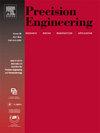New method for testing the laser tracker length measuring unit using a large-scale horizontal arm CMM and its application for assessing the accuracy of distance measurements
IF 3.5
2区 工程技术
Q2 ENGINEERING, MANUFACTURING
Precision Engineering-Journal of the International Societies for Precision Engineering and Nanotechnology
Pub Date : 2025-02-21
DOI:10.1016/j.precisioneng.2025.02.017
引用次数: 0
Abstract
The paper presents a method for determining systematic errors and variability in the readings of a laser interferometer used in laser tracking systems. The method utilizes standalone interferometers treated as references and a large-scale CMM as a system for moving the measurement point, allowing continuous measurement up to a maximum distance of 15 m. Both interferometers use the same corner cube reflector and remain stationary during measurements. The concept and assumptions of the developed method are described as well as key technical issues and their solutions. The research setup, characteristics of the tested and reference systems and the research methodology together with the measurement strategy, are presented. Results obtained with the developed methodology can be used as input data to the simulation model of the laser tracker measuring unit. This model can be used to estimate the length measurement uncertainty after a single measurement of the assessed distance. This paper presents uncertainties obtained by means of the simulation and compares them with ones estimated using statistical analysis of a series of measurements. The conducted validation proved the metrological consistency of the results with uncertainties associated to them for both considered methods. Advantages of the presented method over previously developed methods were also shown. They include faster and simpler adjustment of the tested and reference systems, the general availability of the systems used for moving a measuring mirror (corner cube reflector), use of a single corner cube reflector for both laser systems, making the measurement results independent of the influence of translation and rotation errors of the guide/system responsible for moving the corner cube reflector and considerable reduction of the impact of environmental conditions on the obtained results.
利用大型水平臂三坐标测量机测试激光跟踪仪长度测量单元的新方法及其在距离测量精度评估中的应用
本文介绍了一种确定激光跟踪系统中激光干涉仪读数的系统误差和变异性的方法。该方法利用独立干涉仪作为参考,大型三坐标测量机作为移动测量点的系统,允许连续测量到15米的最大距离。两个干涉仪使用相同的角立方反射器,在测量期间保持静止。阐述了所开发方法的概念和假设,以及关键技术问题和解决方案。介绍了研究设置、被测系统和参照系的特点、研究方法和测量策略。所得结果可作为激光跟踪仪测量单元仿真模型的输入数据。该模型可用于估算评估距离单次测量后的长度测量不确定度。本文给出了通过模拟得到的不确定度,并将其与通过一系列测量的统计分析估计的不确定度进行了比较。所进行的验证证明了两种考虑方法的结果与不确定度相关的计量一致性。该方法与以前开发的方法相比具有优势。它们包括更快和更简单地调整被测系统和参考系统,用于移动测量镜(角立方反射器)的系统的普遍可用性,两个激光系统使用单个角立方反射器,使测量结果独立于负责移动角立方反射器的导轨/系统的平移和旋转误差的影响,并大大减少了环境条件对获得结果的影响。
本文章由计算机程序翻译,如有差异,请以英文原文为准。
求助全文
约1分钟内获得全文
求助全文
来源期刊
CiteScore
7.40
自引率
5.60%
发文量
177
审稿时长
46 days
期刊介绍:
Precision Engineering - Journal of the International Societies for Precision Engineering and Nanotechnology is devoted to the multidisciplinary study and practice of high accuracy engineering, metrology, and manufacturing. The journal takes an integrated approach to all subjects related to research, design, manufacture, performance validation, and application of high precision machines, instruments, and components, including fundamental and applied research and development in manufacturing processes, fabrication technology, and advanced measurement science. The scope includes precision-engineered systems and supporting metrology over the full range of length scales, from atom-based nanotechnology and advanced lithographic technology to large-scale systems, including optical and radio telescopes and macrometrology.

 求助内容:
求助内容: 应助结果提醒方式:
应助结果提醒方式:


